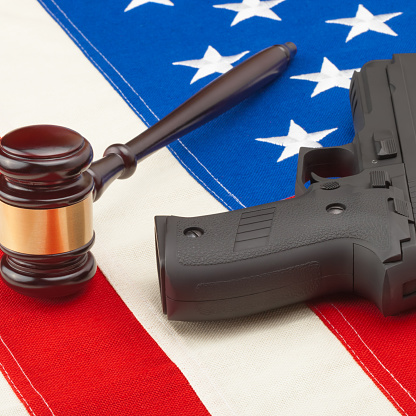
August 27, 2015, by Lindsay Brooke
Virginia shootings – America’s Unexploded Bombs
Blog by Peter J. Ling Professor of American Studies, head of the Department of American & Canadian Studies, member of the Centre for Research on Race and Rights.
Author of Martin Luther King, Jr. (Routledge Historical Biographies).
Vester L. Flanagan II, also known as Bryce Williams, explained his killing of two former TV station colleagues in Roanoke Virginia by declaring that “I’ve been a human powder keg for a while…. Just waiting to go BOOM!!! at any moment.”
Flanagan was keen to ensure that the world knew that he had exploded in a lethal rage. He shot his victims—reporter Alison Parker and cameraman Adam Ward—on live television, uploaded a video of his actions on social media and sent a 22-page letter to ABC news linking what he had done to the Charleston church killings in June of this year. Within days of that event, he had legally acquired the gun with which he killed his victims.
Shootings like this are now something we have come to expect. America is awash with guns and the states with more guns have more gun-related deaths. (Virginia is around average in this respect with around a third of households having guns and a gun-related death incidence ratio of around 15 per 100,000 residents).
There are at least 270 million guns in the US, probably more. As of 2014, it was estimated that there were roughly 89 guns for every 100 Americans. America’s 5% of the world’s population owns nearly a third of civilian owned armaments. Thus the sheer availability of firearms is the key factor in the prevalence of gun violence in public places. A global study of shootings between 1966 and 2012 found that 60% of school and workplace shootings were by Americans. In China, school violence has taken the form of stabbings. While the latest killings took place in a public place, Flanagan’s previous unhappy employment at the TV station (he was fired in 2013) and work-based hostility to the victims make this crime essentially a workplace killing. Thus, the more we learn about Flanagan’s troubled past the less remarkable this tragedy appears.
Apart from being a “live” TV event, the first unexpected aspect of these murders is the fact that the perpetrator is African American and the victims are white. While many firearm fatalities are African American, in most cases they are victims of black-on-black violence, sometimes in the context of gangs and drugs. Since the days of slavery, the spectre of African American vengeance has lived in the white American imagination. Despite the reality that African Americans have rarely sought revenge, white America has historically used the prospect of black violence to justify its own brutal treatment. The reaction of the slave South to uprisings such as Nat Turner’s in 1831 and just as conspicuously, the appalling spate of lynching at the start of the twentieth century offer grim testimony to the way white psychosis feeds on the fear of African American retaliatory violence.
During the classic phase of the civil rights movement in the 1950s and 1960s, it was accepted in Martin Luther King’s inner circle that one of the pragmatic reasons for the use of nonviolent direct action was the recognition that white racism was a mental illness that had repeatedly produced what can fairly be described as psychotic episodes in the white population. Echoes of this assessment, amplified by the Christian admonition to forgive, were evident when relatives of the victims and survivors of the church killings in Charleston used the arraignment of Dylann Roof to declare publicly that they forgave him. This underlined the moral superiority of African Americans and thereby further delegitimized Roof’s actions which he had defended as the beginning of a race war to revive the white South. Flanagan’s actions, in contrast, remind America that within the black community, not everyone is imbued with Christian meekness. Flanagan’s reaction to the Charleston killings was to get a gun and plan revenge.
Given what Flanagan has made public and what his former working associates have divulged, the Virginia shootings also underline the toxic mix of firearms and mental instability. Both Roof and Flanagan can be seen as driven by a pathological narcissism that indulged in violence to secure the attention that their everyday selves craved and did not receive. Flanagan ultimately turned his gun on himself, an ignored detail that reflects the reality that the availability of guns is feeding an epidemic of gun suicide in America; suicides are the majority of America’s gun deaths in 2015. It would probably trouble both Roof and Flanagan that a disaffected white youth and a frustrated, gay, 40-something African American should have common psychological traits, but had the two committed their murders in closer proximity, they could have been collaborators. Roof wanted to start a race war and Flanagan allegedly alluded to this as he opened fire. The cycle of violence and retaliation has often been at the heart of terrorism with its proponents hoping that the reaction to their outrages will be so excessive as to undermine the stability of the social order. White attacks blacks; blacks retaliate; white state power reacts excessively; blacks retaliate; and so on.
There are human powder kegs in every society; individuals operating on what we sometimes call a short fuse. What makes this fact so dangerous in America is the ease with which such people can arm themselves. Media outlets in the US are currently congratulating themselves for having the decency and good sense not to broadcast Flanagan’s film of his killing, and they are probably to be commended given the possibility that seeing it might prompt imitation. Individuals who want to secure attention through violence now have a new apparatus to publicize their deeds and that could prove an explosive combination in itself.
No comments yet, fill out a comment to be the first

Leave a Reply